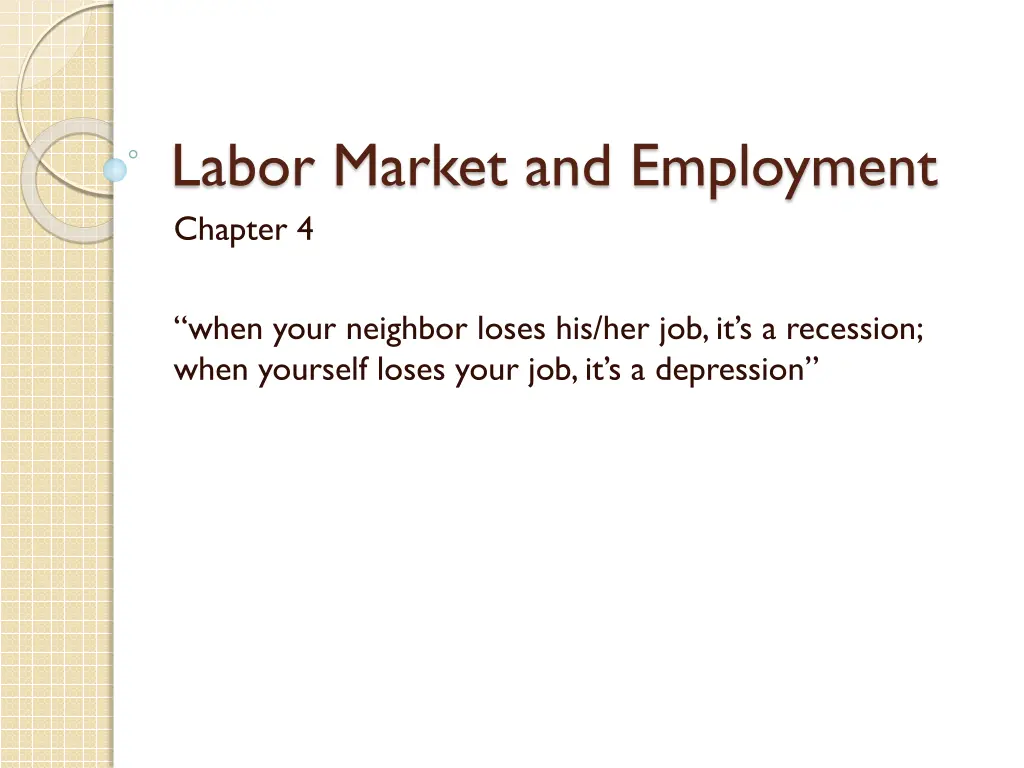
Understanding Labor Market Dynamics and Unemployment Trends
Explore key concepts related to unemployment, the impact of labor market distortions, the anatomy of unemployment, and how supply-demand models shape employment outcomes. This content delves into the fluctuations in unemployment rates across demographics and regions, labor market supply and demand dynamics, and the influence of shocks on the labor market.
Download Presentation

Please find below an Image/Link to download the presentation.
The content on the website is provided AS IS for your information and personal use only. It may not be sold, licensed, or shared on other websites without obtaining consent from the author. If you encounter any issues during the download, it is possible that the publisher has removed the file from their server.
You are allowed to download the files provided on this website for personal or commercial use, subject to the condition that they are used lawfully. All files are the property of their respective owners.
The content on the website is provided AS IS for your information and personal use only. It may not be sold, licensed, or shared on other websites without obtaining consent from the author.
E N D
Presentation Transcript
Labor Market and Employment Chapter 4 when your neighbor loses his/her job, it s a recession; when yourself loses your job, it s a depression
Goals Some basic concepts related to unemployment; How a basic supply-demand model helps us understand the labor market; How labor market distortions like taxes and firing costs affect employment in the long run; The costs of unemployment; A key fact about the labor market: the return to a college education has risen enormously over the past half century;
Unemployment o Unemployed person: Someone who is out of work and: 1)Has actively looked for work in the last four weeks, or 2)Is waiting to be recalled to a job after having been laid off, or 3)Is waiting to report to a new job within four weeks.
The Anatomy of Unemployment o The Canadian unemployment rate exhibits the following characteristics: o Large variations in unemployment rates across age groups and across populations. o Job creation and job destruction are the gross flows of jobs that are being created and destroyed every month as part of normal changes in the Canadian economy. o In normal times, most spells of unemployment are relatively short. o People who are unemployed for long periods account for most of the unemployment.
The Anatomy of Unemployment Unemployment Rates Across Various Demographic Groups, 1976-2002
The Anatomy of Unemployment Unemployment Rates Across Regions, 1976-2002
Labor Market Supply and Demand The labor demand curve is derived from the firm's profit maximization problem. Firms hire workers until the MPL equals the wage rate. The demand curve slopes downward because of the diminishing marginal product of labor. As we add more workers and hold all else equal, each additional worker produces less. The labor supply curve slopes upward because the price of leisure is higher when wages are higher. The intersection of labor supply and demand determines the level of employment and the wage rate.
Shocks in labor market A Change in Labor Supply the government collects a tax on a worker's wage, the labor supply curve shifts upwards Equilibrium wages rise, firms will fire some workers and the unemployment rate will rise. However, over time, workers will become discouraged and may drop out of the labor force. If all workers become discouraged, the unemployment rate is unchanged in the long run
Shocks in labor market Suppose the government creates regulations making it harder to fire workers. Thus, firms will demand fewer workers in the first place, because they will not be able to fire them later. Labor demand shifts left causing wages and employment fall. The unemployment rate rises initially and recovers as discouraged workers drop out of the labor force.
Wage rigidity Wage rigidity is when wages fail to adjust after a shock to labor demand or supply. If wages are rigid in the example of labor demand given above, the failure of wages to fall to clear the labor market will result in a larger fall in employment.
Case study Supply and Demand Shocks in the Canadian Labor Market Increases in the employment-population ratio are due in large part to increases in the number of women working. Supply shocks include changes in social norms and changes in technology for managing fertility. Demand shocks include reduced discrimination against women.
Case study The Actual Rate of Unemployment and the Estimated Natural Rate of Unemployment, 1950-2002 Rising unemployment in the 1960s and 1970s and the subsequent decline in the 1980s is possibly explained by the baby boom. Young people have higher unemployment rates traditionally and the baby boom increased the proportion of young people in those decades.
Labor market around the world Unemployment in Europe has been substantially above America's rate since 1980, while Japan's rate was until recently below the United States. European unemployment has increased dramatically because: Adverse shocks (the productivity slowdown and high oil prices) hit Europe and other countries. Inefficient labor market institutions exist in Europe, because unemployment and welfare benefits are substantially higher.
The Anatomy of Unemployment o Unemployment Pool: The number of unemployed people at any point in time. o Reasons for becoming unemployed: o A person may be a new entrant or re- entrant into the labour force. o A person may quit a job in order to look for alternative employment and may register as unemployed while searching. o A person may be laid-off.
The Anatomy of Unemployment o Reasons for moving out of the unemployment pool: o A person may be hired into a new job. o Someone laid off may be recalled by his or her employer. o An unemployed person may stop looking for a job.
The Anatomy of Unemployment o Reasons for moving out of the unemployment pool: o A person may be hired into a new job. o Someone laid off may be recalled by his or her employer. o An unemployed person may stop looking for a job.
The bathtub model of unemployment The "bathtub" model is consists of two equations. The second equation determines how unemployment changes over time. The job separation rate is the fraction of people who start out with jobs but who lose their jobs each month. The job finding rate is the fraction of unemployed people who find a new job each month.
The bathtub model of unemployment When the change in unemployment is zero, the model is in steady state and the number of people losing jobs exactly equal Because the equilibrium of the model is in steady state, we think of the model as determining the natural rate of unemployment.
The rising return to education The wage premium to having a college degree relative to a high school degree has been rising rapidly over the last forty years. The wage premium of a college degree over a person's years worked far outweighs the forgone wages and tuition costs of going to college.
The rising return to education As wages have grown, so has the supply of college graduates such a supply shock implies wages should decline. Because the supply of workers has increased, it must also be the case that the demand for college-educated workers has increased by an amount large enough to offset supply.
The rising return to education Explanations for a large shift in demand for highly educated workers include the following: Skill-biased technical change is the idea that new technologies are more effective at improving productivity of college-educated workers than of high school educated workers. Globalization is the increased opening of trade. Because highly educated workers are a scarce resource in the world as a whole, trade will raise wages of college-educated workers.






















